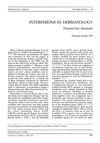Search
forLearn
3 / 3 resultslearn Osteopontin
signaling protein that, when suppressed, may grow hair by reducing inflammation and stem cell loss
learn Redensyl
commercial product with a blend of mostly natural ingredients for hair regrowth
Research
5 / 1000+ results
research A Novel Therapeutic Paradigm for Patients with Extensive Alopecia Areata
New treatments targeting immune pathways show promise for severe hair loss but need more research for safety and effectiveness.

research Cannabinoid Compounds as a Pharmacotherapeutic Option for the Treatment of Non-Cancer Skin Diseases
Cannabinoids like CBD and THC may help treat non-cancer skin diseases, but more research is needed.

research The JAK/STAT Signaling Pathway: From Bench to Clinic
The JAK/STAT pathway is important in cell processes and disease, and JAK inhibitors are promising for treating related conditions.

research Interferons in Dermatology
Interferons are effective for some skin conditions and cancers, but can have side effects and need more research for optimal use.

research Hair Growth Under Dupilumab in Alopecia Areata Universalis and Atopic Dermatitis
Dupilumab can help regrow hair and improve skin conditions in patients with severe atopic dermatitis and alopecia areata.
Community Join
5 / 113 resultscommunity The Real Cause Of Androgenetic Alopecia
Androgenetic alopecia is caused by DHT affecting hair growth. Finasteride and minoxidil are used to manage hair loss by blocking DHT and promoting hair growth.
community HLT Megathread on HMI-115 (key takeaways in comments)
HMI-115, a newly discovered hair loss treatment that could potentially be effective for those with diffuse thinning and telogen effluvium. It is based on prolactin receptor antagonist signaling and has already undergone Phase I trials in women, with potential commercialization by 2027.
community Breaking hair loss news! GT20029 is a resounding success!
GT20029, a new hair loss treatment, shows promising results but only a slight improvement over placebo. People are cautiously optimistic, discussing its potential and combining it with existing treatments like Minoxidil and Finasteride.

community Compressed part of research of theory of androgenic/anabolitic balance. AGA h-responders analytic. Theory of physio-metabolitic method of anti AGA treatment
The treatment for androgenetic alopecia involves using finasteride and minoxidil with intense exercise and cold exposure to boost metabolism and reduce androgenic effects, potentially leading to hair regrowth. This approach may activate biological pathways for improved hair and overall health.
community Finasteride does deplete important nuero-active steroids
Finasteride can reduce neuroactive steroids, causing side effects like depression, anxiety, and sexual dysfunction. Some users experience persistent symptoms after stopping finasteride, while others use alternative treatments like topical solutions.